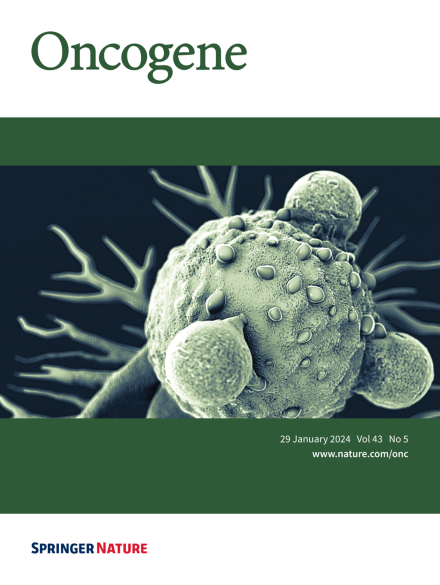新型蛋白SEMA3C-319aa引发胃癌中谷胱甘肽代谢依赖性铁下垂。
IF 7.3
1区 医学
Q1 BIOCHEMISTRY & MOLECULAR BIOLOGY
引用次数: 0
摘要
胃癌(GC)缺乏有效的靶向治疗继续限制患者的生存。环状rna (circRNAs),已知作为表观遗传调节剂,也可能编码功能蛋白。在这项研究中,RNA-seq结合核糖体分析(Ribo-seq)对人胃癌细胞进行了鉴定,发现了一个非标准翻译的环状rna circSEMA3C,它编码一个新的319个氨基酸(aa)蛋白SEMA3C-319aa。在功能上,circSEMA3C和SEMA3C-319aa在体外和体内均抑制胃癌细胞活力和肿瘤生长。利用蛋白质组学和代谢组学,我们发现SEMA3C-319aa靶向GC中与铁中毒相关的代谢物和代谢途径。值得注意的是,SEMA3C-319aa上调多不饱和脂肪酸链的产生,抑制谷胱甘肽代谢,特别是谷胱甘肽循环,从而抑制GPX4活性。从机制上说,SEMA3C-319aa与LDHA结合,并通过其非规范核定位信号(NLS),序列将LDHA运送到细胞核中,在那里它增强E3连接酶PARK2的转录,促进GPX4降解。此外,在体内,SEMA3C-319aa和GPX4抑制剂RSL3联合治疗比单药治疗更有效。综上所述,我们的研究结果揭示了一种由SEMA3C-319aa介导的新的nls依赖性核易位机制,并确定了一种新的GC铁凋亡途径。SEMA3C-319aa可能为胃癌提供有希望的辅助治疗策略。本文章由计算机程序翻译,如有差异,请以英文原文为准。

The novel protein SEMA3C-319aa triggers glutathione metabolism-dependent ferroptosis in gastric cancer
The lack of effective, targeted therapies for gastric cancer (GC) continues to limit patient survival. Circular RNAs (circRNAs), known to act as epigenetic regulators, may also encode functional proteins. In this study, RNA-seq combined with ribosome profiling (Ribo-seq) of human GC cells identified a non-canonically translated circRNA, circSEMA3C, which encodes a novel 319-amino-acid (aa) protein, SEMA3C-319aa. Functionally, both circSEMA3C and SEMA3C-319aa suppressed GC cell viability and tumor growth in vitro and in vivo. Using proteomics and metabolomics, we found that SEMA3C-319aa targets ferroptosis-associated metabolites and metabolic pathways in GC. Notably, SEMA3C-319aa upregulated the production of polyunsaturated fatty acid chains and inhibited glutathione metabolism-particularly the GSH cycle-thereby suppressing GPX4 activity. Mechanistically, SEMA3C-319aa binds to LDHA and, via its non-canonical nuclear localization signal (NLS), sequence shuttles LDHA into the nucleus, where it enhances transcription of the E3 ligase PARK2, promoting GPX4 degradation. Furthermore, combination treatment with SEMA3C-319aa and the GPX4 inhibitor RSL3 was more effective than monotherapy in vivo. Taken together, our findings reveal a novel NLS-dependent nuclear translocation mechanism mediated by SEMA3C-319aa and identify a new ferroptosis pathway in GC. SEMA3C-319aa may offer a promising adjuvant therapeutic strategy for GC.
求助全文
通过发布文献求助,成功后即可免费获取论文全文。
去求助
来源期刊

Oncogene
医学-生化与分子生物学
CiteScore
15.30
自引率
1.20%
发文量
404
审稿时长
1 months
期刊介绍:
Oncogene is dedicated to advancing our understanding of cancer processes through the publication of exceptional research. The journal seeks to disseminate work that challenges conventional theories and contributes to establishing new paradigms in the etio-pathogenesis, diagnosis, treatment, or prevention of cancers. Emphasis is placed on research shedding light on processes driving metastatic spread and providing crucial insights into cancer biology beyond existing knowledge.
Areas covered include the cellular and molecular biology of cancer, resistance to cancer therapies, and the development of improved approaches to enhance survival. Oncogene spans the spectrum of cancer biology, from fundamental and theoretical work to translational, applied, and clinical research, including early and late Phase clinical trials, particularly those with biologic and translational endpoints.
 求助内容:
求助内容: 应助结果提醒方式:
应助结果提醒方式:


